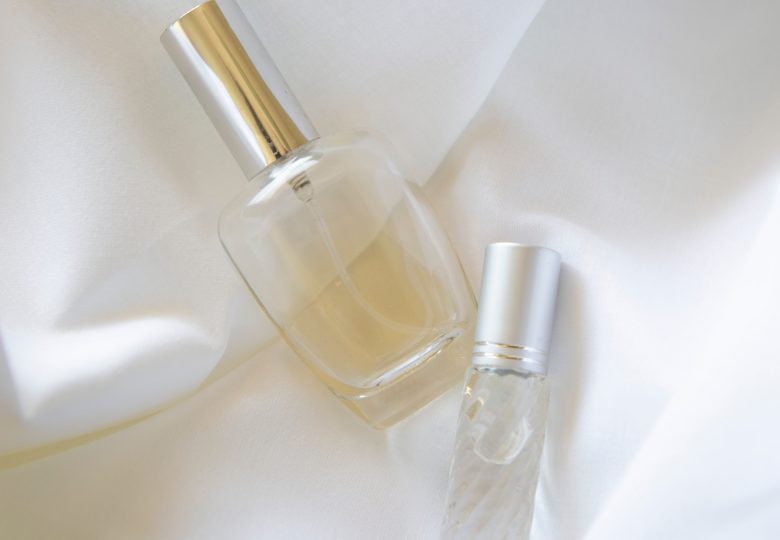Chemical of the Month: Perfume

by toxicologist Ewa Daniél
Perfume – What is it?
Perfume is one of the oldest man-made chemicals. It can be made both synthetic from chemical substances or natural from essential oils such as extracts from flowers and plants and contain from 10 to 300 different fragrances.
It can be used in different concentrations depending on the type of product.The most concentrated is perfume itself, next comes Eau de Parfumwith a concentration of 15-20 % perfume, then Eau de Toilette with 2-6% and Eau de Cologne 2-4% perfume. Perfumed creams and lotions usually contain 0,1-0,3 % perfume.
In Europe perfume is regulated by law and must be declared on cosmetic products and detergents with either the word perfume or fragrance. Used in food, beverage and dental products it will be declared as aroma.
In 2005 it was decided by law in EU that a limited list of 26 fragrances should be declared not only as perfume, but also by name in a certain concentration when they are used in both cosmetic products and detergents.
For products that are rinsed off like shampoo, soap and the like the limit is 0,01% and for products meant to stay on your body like creams, body lotion, deodorant the limit is 0,001 %.
You can see the list here:https://allergycertified.com/how-to-certify/criteria/
So, what is the problem?
Unfortunately, perfumes can add not only good odour, but also perfume allergy.
Perfume allergy is not something you inherit from you parents, but something everyone can develop, if you are exposed to too much perfume over time. And beware, it is not only the 26 perfumes that need to be declared that causes allergy.
All perfumes are allergenic when in contact with skin.
A European population study have shown that 4,5 % of adults between 18-74 years have allergy to perfume, and 16 % of eczema patients are sensitized to fragrance ingredients. And the number could be even higher.
Since perfume consists of hundreds of different components it is not possible to test for all. So usually the dermatologist will do two different tests called Fragrance Mix I and Fragrance Mix II. They are both mixes of several perfumes. Fragrance Mix I contain eight fragrances and Fragrance Mix II contains six.
This means that all in all patients are tested for perfume allergy towards fourteen different perfumes. But with hundreds of perfumes, there is a risk you will not detect an allergy when only testing with fourteen perfumes.
A Danish study show that patch testing with 26 perfumes can identify forty percent more patients with perfume allergy compared to only testing with Fragrance Mix I and Fragrance Mix II.
The tendency in allergy to perfume has changed from being the elderly woman to also men, teenagers and children down to 3 years having allergy to perfume.
Synthetic or natural perfume
Many consumers believe that there is a big difference between perfume from essential oils and synthetic perfume, and that natural perfume is less allergenic than synthetic, but natural or synthetic origin make no difference when it comes to allergy.
Actually, some of the most allergenic perfumes come from nature. Nineteen of the fragrances on the list of the 26 perfumes that have to be declared (see above) can be found in natural plants and have natural origin.
I would like to give you an example:
Below you see Linalool; a perfume known to cause allergy.
Linalool can be found both natural origin and synthetic, but as you see in the picture, theyare chemically similar and they also behave the same way, so the only difference is actually your point of view.


Synthetic Linalool Natural Linalool
AllergyCertified
Fragrance is known as one of the main causes of skin allergy, and whether the perfume is natural or synthetic does not make a difference when it comes to allergy therefore AllergyCertified does not allow any perfume in certified products, nor is fragrance allowed in raw materials or as impurities found in the certified products.
Litterature:
- Anne Birgitte Simonsen et al, Contact allergy and allergic contact dermatitis in children- a review of current data, 2011, 65 (5) 254-265
- Bennike NH, Zachariae C, Johansen JD. Non-mix fragrances are top sensitizers in consecutive dermatitis patients - a cross-sectional study of the 26 EU-labelled fragrance allergen. Contact Dermatitis. 2017 Nov;77(5):270-279.
- Gimenez Arnau et al. Identification of Lilial® as a fragrance sensitizer in a perfume by bioassay‐guided chemical fractionation and structure‐activity relationships; Contact Dermatitis, 2000, 43:351-359
- European Commission, Health and consumers, Perfume allergies https://ec.europa.eu/health/scientific_committees/opinions_layman/perfume-allergies/en/index.htm
- Heisterberg MV et al. Contact allergy to the 26 specific fragrance ingredients to be declared on cosmetic products in accordance with the EU Cosmetic Directive.Contact Dermatitis 2011, 65(5):266-75.
- Heisterberg MV, et al Deodorants are the leading cause of allergic contact dermatitis to fragrances. Contact Dermatitis 2011, 64(5):258–264
- Miljøstyrelsen: mst.dk/kemi/kemikalier/parfumeogallergi/
- Miljøstyrelsen: notat vedr. deklaration af parfumestoffer i kosmetiske produkter samt anprisning af fravær af parfumestoffer i kosmetiske produkter
- SCANCOS conference “Know your ingredients: Perfume; 21-22. November 2019
- Videncenter for allergi;http://www.videncenterforallergi.dk/wp-content/uploads/files/Patientinformation/patinf-parfume-2015.pdf
- Scientific Committee on Consumer Safety, SCCS Opinion on Fragrance allergens in cosmetic products, 2012. SCCS/1459/11
- Scientific Committee on Consumer Safety, SCCS Opinion on Fragrance allergens in cosmetic products, 2019. Allergic contact dermatitis to fragrance: A review
- Icons by Freepik, Iconixar, Smashicons, Kiranshasty from flaticon.com
